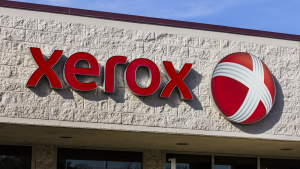As 2023 comes to a close, now may be a great time to figure out which stocks to sell. If you are an income-focused investor, this may entail figuring out the top dividend stocks to sell. While these stocks may, on paper, offer steady returns, they may not necessarily be on track to produce satisfactory total returns.
For one, just because a stock continues to pay out a high dividend doesn’t mean the payouts will continue. Dividends can always be cut/suspended, and plenty of high-yield dividend stocks are at risk of experiencing a dividend reduction.
Even in cases where the company, in question, remains well-positioned to maintain its rate of payout, other factors can negatively affect the stock price, creating losses that outweigh the gains generated from the payouts. In fact, here are seven dividend stocks to sell today.
Best Buy (BBY)

Source: Ken Wolter / Shutterstock.com
Best Buy (NYSE:BBY) shares have been in a slump for nearly two years. Factors like the post-pandemic slowdown in tech demand, lingering recession worries, and the impact of high inflation on margins have put a good deal of pressure on this consumer electronics stock.
Some may believe that, at current prices, BBY stock has become a “worst is priced in” situation, where those willing to buy now can collect a 5.29% dividend and wait for a rebound. Yet while BBY may not be at risk of a dividend cut, it’s questionable whether the stock has much potential to begin a recovery in the months ahead.
A few weeks back, when Best Buy reported quarterly results, the company walked back guidance, noting it expects sales declines this quarter (3% to 7%) that exceed prior estimates. Further disappointment may drive additional price declines, perhaps making it best to stay away for now.
Deluxe (DLX)

Source: Shutterstock
Deluxe (NYSE:DLX) may be best known for its check printing business. Misunderstood, with a low valuation (5.5 times forward earnings) and a high dividend yield (6.64%), it’s easy to jump to the conclusion that this is one of the dividend stocks to buy, not one of the dividend stocks to sell. However, it is also quite easy to counter such a take on DLX stock.
Deluxe’s modernization efforts have not translated into revenue or profitability. Sell-side forecasts call for weak earnings growth to continue. Furthermore, as a Seeking Alpha commentator has pointed out, DLX has a highly leveraged balance sheet. A slight deterioration of Deluxe’s fundamentals could have an outsized negative impact on the stock.
Medifast (MED)

Source: shutterstock.com/Black Salmon
Following the success of Novo Nordisk’s (NYSE:NVO) weight loss drugs Ozempic and Wegovy, there’s been growing concern among investors about the impact of these drugs on the health of companies in the weight loss market, and Medifast (NYSE:MED) is no exception.
Sometimes investors can overreact to the emergence of a disruptive product. In turn, prematurely bail on the “disrupted” market incumbent. Unfortunately, that’s not the story here with MED stock. Wall Street appears to be on the money, when it comes to its increasingly bearish view on the weight loss products/services provider’s shares.
During the September quarter, Medifast’s sales fell 39.6% year-over-year. Earnings per share fell by over 35%. Unless earnings stabilize, Medifast may be at risk of cutting or suspending its $1.65 per share quarterly dividend. Keep this in mind, if you’re tempted by MED’s nearly 10% forward dividend yield.
Medical Properties Trust (MPW)

Source: venusvi / Shutterstock.com
This isn’t the first time I’ve called Medical Properties Trust (NYSE:MPW) one of the top dividend stocks to sell. Back in August, I noted that poor results and tenant troubles point to more pain ahead for investors in this healthcare property-focused real estate investment trust (or REIT).
Not too long after my prior critique of MPW stock, the REIT announced a dividend cut. With subsequent price declines, shares still sport a high forward yield (12.85%). However, as the aforementioned issues persist, it is highly questionable whether more cuts are just around the corner.
Plenty of investors have been burned trying to catch this falling knife. Mostly, on the view that the high payout, plus prior declines, make up for the underlying risk. Yet with little signs out there that MPW is about to get out its continued downward spiral, consider avoiding it your best move.
Walgreens Boots Alliance (WBA)

Source: saaton / Shutterstock.com
Finding support in the low-$20s per share, on the surface it may seem like “Dog of the Dow” stock Walgreens Boots Alliance (NASDAQ:WBA) has finally become a bottom-fisher’s buy worth considering. After all, as I discussed earlier this month, the pharmacy chain has recently kicked off a turnaround.
With this, it could appear like you can buy WBA stock today, and wait for a recovery, all while collecting a princely dividend (9.21% forward annual yield). However, there’s a good reason why the market has priced Walgreens in a way that gives the stock both a super-high forward yield, as well as a super-low forward valuation (6.3 times forward earnings).
Although the company has indicated no plans at this time to alter the dividend, what if current turnaround efforts fail to have the intended effect? Walgreens may have to reduce the payout in order to conserve cash.
Western Union (WU)

Source: DW labs Incorporated/Shutterstock.com
Western Union (NYSE:WU) is another of the dividend stocks to sell, due to risks associated with technological disruption. Competition from fintech platforms has resulted in a slow and steady decline in operating performance for this well-known and more than century-old money transfer services firm.
WU’s 7.79% forward dividend is nothing to sneeze at. For now, the dividend is sustainable. Still, don’t make the mistake of assuming that you can buy WU stock, collect the 7.79% dividend, and at worst sell it down the road for approximately your purchase price. Why?
Barring unforeseen greater success with its transformation efforts/diversification into other types of consumer financial services, Western Union’s earnings will likely stay on a downward trajectory. In turn, driving WU shares to even lower prices. Unrealized losses on your investment could pile up. In time, these losses could end up vastly exceeding the amount of dividends collected.
Xerox (XRX)

Source: Jonathan Weiss/ShutterStock.com
Xerox (NYSE:XRX) is yet another dividend stock that I have warned about previously. Back in June, I argued that while the workplace technology company’s shares traded at a low earnings multiple, XRX was in fact pricey, when one takes declining earnings into account.
Since laying out this bear case, XRX stock has declined only modestly, falling by around 4.5% during this time frame. However, on an annualized basis, these declines exceed the stock’s forward annual dividend yield (currently at 7.23%).
Management may be in the midst of implementing a strategic transformation plan, but until these efforts get the company back into growth mode, the risk of further price declines for XRX still looms. The fact activist investor Carl Icahn decided to sell his Xerox stake back to the company rather than hold on through the latest turnaround is another sign of the high uncertainty with this turnaround.
On the date of publication, Thomas Niel did not hold (either directly or indirectly) any positions in the securities mentioned in this article. The opinions expressed in this article are those of the writer, subject to the InvestorPlace.com Publishing Guidelines.











